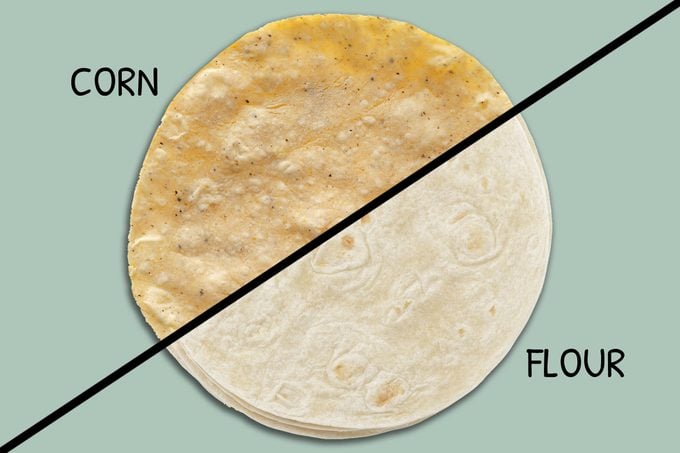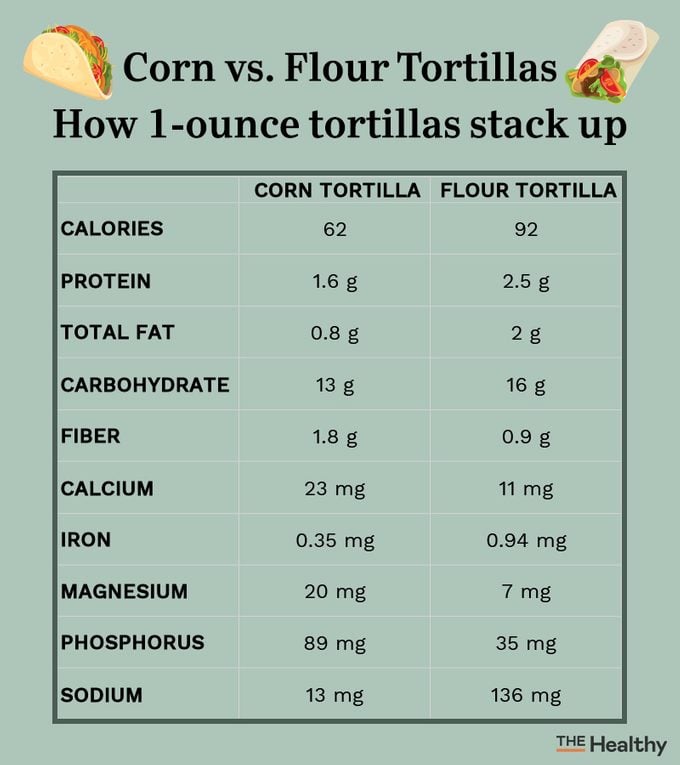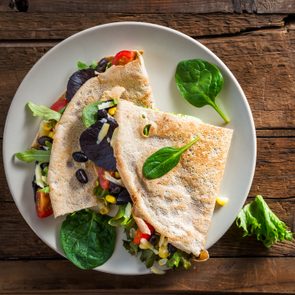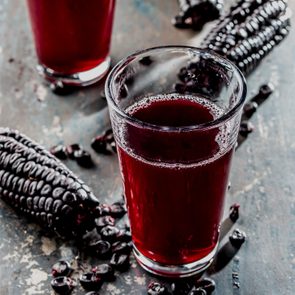Corn vs. Flour Tortilla: Which One Is Healthier?
Updated: Nov. 07, 2022
Some recipes may work best with corn, and you might prefer flour—but which tortilla is actually better for you?
Our editors and experts handpick every product we feature. We may earn a commission from your purchases.
Corn vs. flour tortilla: What’s the difference?
If you’re trying to boost your diet with some healthier choices, you’ll probably come across a lot of advice to eat more non-starchy veggies, like tomatoes; focus on healthy fats, like in avocados; and try (at least occasionally) to use beans in place of meat. Sounds like taco time to us! Or maybe it’s fajita, burrito, quesadilla, or enchilada night. Whichever the choice, they all begin with the tortilla. But when selecting between a corn vs. flour tortilla, which is the right pick for you?
Tortillas come in several sizes, which you’ll ideally pick based on your culinary need (a footlong tortilla is way too big to make a tidy, hand-held street taco), but they also come in different varieties. And while certain recipes work best with corn tortillas, some are better matches for flour tortillas, and still others are interchangeable.
Culinary preference aside, is one type of tortilla healthier than the other? Let’s find out.
Get The Healthy @Reader’s Digest newsletter

What is a corn tortilla?
“Corn tortillas are a whole-grain food,” says Christy Wilson, RDN, a nutrition counselor at the University of Arizona’s Campus Health Service in Tucson. “They’re traditionally made from ground field corn (maize) that’s then made into masa harina.”
It’s not like using corn straight from the cob.
“Raw, ground corn is treated with limewater (calcium hydroxide, or cal), which softens the corn and gives the masa harina—and ultimately the tortillas—a distinct, savory flavor,” says Wilson.
Getting technical, this corn processing technique is called nixtamalization, and it also boosts nutritional value and reduces cancer-causing substances called aflatoxins.
The tortillas are typically made by combining masa harina (finely ground cornmeal) with warm water and sometimes salt, forming the mixture into dough, and then portioning into individual balls. The masa dough balls are then pressed into tortillas, typically using a tortilla press.
The final step is cooking the tortilla in a hot, cast iron pan or comal (griddle) until golden brown and puffy, no more than a couple of minutes per side.
While often yellow, the tortillas may also be naturally white, blue or purple, based on the cornmeal chosen. (Yes, blue and purple corn exist in nature—no artificial colors are involved.)
Corn tortillas are typically used for making street tacos, traditional tacos, enchiladas, taquitos and chilaquiles. They can also be fried for making taco shells or tortilla chips.
Sound like fun? Follow this tutorial to make your own corn tortillas, and try Maseca Instant Yellow Corn Masa Flour as the main ingredient.
Are Tacos Healthy? Yes, and These 4 Recipes Prove It
What is a flour tortilla?
Flour tortillas are often made by combining all-purpose white flour, warm water, vegetable oil (or shortening or lard), salt and sometimes a bit of baking powder. Unlike corn tortillas, they are not a whole-grain food.
Making flour tortillas involves kneading the ingredients into a smooth dough, portioning the dough into individual testales (small disks), and rolling out the disks into individual tortillas. The tortillas are quickly cooked in a hot, cast iron pan or comal (griddle) until golden brown in spots, which takes just one minute (or less) per side.
Other flours can be swapped in place of white flour. Whole wheat pastry flour works well as a replacement, providing whole grain goodness, including fiber.
Flour tortillas are typically used for making burritos, quesadillas, fajitas, flautas, and Tex Mex-style soft tacos.
Want to make your own flour tortillas? Try this homemade tortilla recipe. Using oil rather than shortening or lard makes them heart friendlier.
How to Make a Healthy Breakfast Quesadilla, According to Registered Dietitians
Corn vs. flour tortilla: Nutrition facts
When comparing the nutritional value of corn vs. flour tortillas, remember that you usually won’t be eating equivalent amounts. Popular sizes for corn tortillas are five to six inches for tacos (about 1 ounce); flour tortillas are seven to eight inches for soft tacos (about 1.5 to 2 ounces), 10 inches for quesadillas (about 2.5 ounces), or 12 inches for burritos (about 3 to 4 ounces).
Factor size into your selection; the larger a tortilla is the more nutrients you’ll be eating—and the more calories. Here’s how corn vs. flour tortillas stack up.

Corn tortilla
A 1-ounce (28.35 gram) corn tortilla has the following nutrients and daily values (DV):
Calories: 62
Protein: 1.6 g (3 percent DV)
Total fat: 0.8 g (1 percent DV)
Carbohydrate: 13 g (5 percent DV)
Fiber: 1.8 g (6 percent DV)
Calcium: 23 mg (2 percent DV)
Iron: 0.35 mg (2 percent DV)
Magnesium: 20 mg (48 percent DV)
Phosphorus: 89 mg (7 percent DV)
Sodium: 13 mg (<1 percent DV)
Standout nutrients in corn tortillas
You’ll find notable amounts of dietary fiber, magnesium, phosphorus and pantothenic acid in corn tortillas.
In fact, you’ll get about half of your recommended daily dose of magnesium from a 1-ounce corn tortilla. Magnesium plays a key role in muscle and nerve function, protein synthesis, and energy production. Plus, the mineral is “good for bone health and a healthy, steady heart rate,” says Wilson.
Thanks to wholesome corn, you’ll find beta carotene, betaine, lutein and zeaxanthin, among other health-protective antioxidants. Lutein and zeaxanthin are highly beneficial carotenoids for eye health. They may reduce the risk of age-related macular degeneration, which can lead to blindness.
20 Simple Habits That Can Improve Your Vision
Flour tortilla
A 1-ounce (28.35 gram) flour has the following nutrients and DV:
Calories: 92
Protein: 2.5 g (5 percent DV)
Total fat: 2 g (3 percent DV)
Carbohydrate: 16 g (6 percent DV)
Fiber: 0.9 g (3 percent DV)
Calcium: 11 mg (1 percent DV)
Iron: 0.94 mg (5 percent DV)
Magnesium: 7 mg (17 percent DV)
Phosphorus: 35 mg (3 percent DV)
Sodium: 136 mg (6 percent DV)
Standout nutrients in flour tortillas
Wilson points out that the white flour used in traditional flour tortillas is enriched with nutrients. You’ll find significant amounts of magnesium, selenium, and the B vitamins thiamin and folate in the tortillas.
Women who don’t get enough folate are at greater risk of giving birth to babies with neural tube defects. Since women between the ages of 15-49 are at risk for an inadequate intake of folate, flour tortillas may be an easy, tasty choice for them to help avoid a deficiency.
7 Top Foods High in Folic Acid and Folate
Match your tortilla to your diet
Corn tortillas may be the ideal pick when following a vegan, gluten-free or low-calorie eating plan. That’s because authentic flour tortillas are sometimes made with lard (that’s pig fat, so incompatible with a vegan diet) and they’re based on wheat, which contains gluten. They tend to have more calories than corn tortillas (although check the nutrition information on the package).
Wilson adds that corn tortillas are low in calories because they’re smaller than a typical flour tortilla too.
Size and texture matters
“The smaller-sized corn tortilla is perfect for tacos and for picking up slow-cooked meats and beans off of my plate,” says Wilson. “They’re also perfect for stuffing, rolling to make enchiladas, or stuffing, rolling and frying them into a finger food called flautas [also known as taquito].”
And if you want to fry up a batch of tortilla chips, Wilson says that “the thick texture of corn tortillas works really well.”
The larger, softer, and more-pliable flour tortillas are great for stuffing and rolling to make burritos. They’re also ideal for sandwich wraps.
“Meats, eggs, cheese, rice, guacamole, salsa, beans, vegetables and cilantro can all be packed in and rolled into a big flour tortilla,” says Wilson.
Got high-energy needs? A flour tortilla is your friend.
“You can safely hold a few pounds of food in your hand when it’s wrapped inside of a warm flour tortilla,” she says. “Physically, they’re much larger (up to 24 inches in diameter) and can carry more food.”
10 High-Energy Foods You’ll Want to Add to Your Diet for a Quick Pick-Me-Up
How to shop for tortillas
Before plopping a package of tortillas into your shopping cart, here are some things to consider.
Buy based on what you’re cooking
“I will buy a particular type [of tortilla] depending on what I’m serving them with,” says Wilson. “If it’s tacos I’m making, corn is it; if I’m making chicken quesadillas as my meal, I’ll go with larger, flour tortillas.”
Don’t be tricked by color
Sometimes a color is an indicator of healthfulness. But not always.
“Although added vegetables to a favorite food like tortillas may sound ‘healthy,’ check the ingredient list. Oftentimes it’s the last ingredient listed, which indicates there isn’t much of it,” says Wilson.
More often than not, your “veggie” tortillas add little in the way of nutrition and simply offer you a different color.
Sneaking Veggies Into Your Daily Diet
Factor in wholesomeness
The cornmeal used in corn tortillas is based on the whole corn kernel.
The all-purpose (white) flour often used in flour tortillas doesn’t use the whole wheat kernel—it’s stripped of the germ and bran, which strips away some antioxidant benefits and fiber.
To get whole grain benefits with flour tortillas, look for whole wheat, whole grain or sprouted whole grain varieties.
Also, since corn can be genetically modified (GMO), and since some added fats in flour tortillas may be derived from genetically modified sources, look for USDA certified organic tortillas or Non-GMO Project verified tortillas if you prefer to avoid GMOs.
This Is the Real Difference Between Whole Wheat and Whole Grain
Check out new arrivals
In addition to various types, sizes, and colors of corn and flour tortillas, there are nutrient-rich additions. And a growing number of options don’t contain corn or flour at all.
Here are the newest finds you might want to try:
- La Tortilla Factory offers a wide array of tortillas, including whole wheat protein tortillas that use a pea and rice protein blend.
- Siete Foods has grain-free tortillas featuring chickpea flour, almond flour, or a blend of cassava and coconut flours.
- Angelic Bakehouse makes sprouted whole grain wraps/tortillas that contain juiced or dried veggies.
- Mission Foods has a line of organic tortillas.
- Caulipower offers (you guessed it) cauliflower tortillas made with or without grains.
Corn vs. flour tortilla: Which is healthier?
Though there’s an enticing array of tortillas available on the market today, the most popular picks are still traditional corn or (white) flour tortillas.
They both offer a bevy of nutrients, but there is a best overall pick.
“If we’re strictly talking about health and nutrition, corn tortillas are a few steps ahead of flour because they’re higher in fiber, calcium and magnesium and lower in total carbohydrates and calories,” says Wilson.
Plus, corn tortillas are higher in antioxidant power, considered slightly less processed and gluten free. They’re the way to go if these are important attributes for you.
“Although, because [corn tortillas] are smaller, the ultimate risk is eating several in one sitting,” says Wilson. “So, as always, be mindful of your portions.”
In any case, don’t stress out over tortilla selection.
When choosing between corn vs. flour tortillas, know that you can’t go wrong by stuffing your tortilla of choice with boatloads of veggies, beans and a luxurious dollop of guacamole.
For more wellness updates, follow The Healthy on Facebook, Instagram, and Twitter. Keep reading:
- Gut Inflammation Could Lead to This Nerve-Degenerative Disease, Says New Study
- 10 Foods That You Shouldn’t Reheat in a Microwave
- What Are the Heart-Healthiest Foods? A Cardiologist Just Opened Her Fridge to Reveal Them
- Can’t Sleep? A Metabolism Scientist Says This Is the #1 Solution for Sleepless Nights























